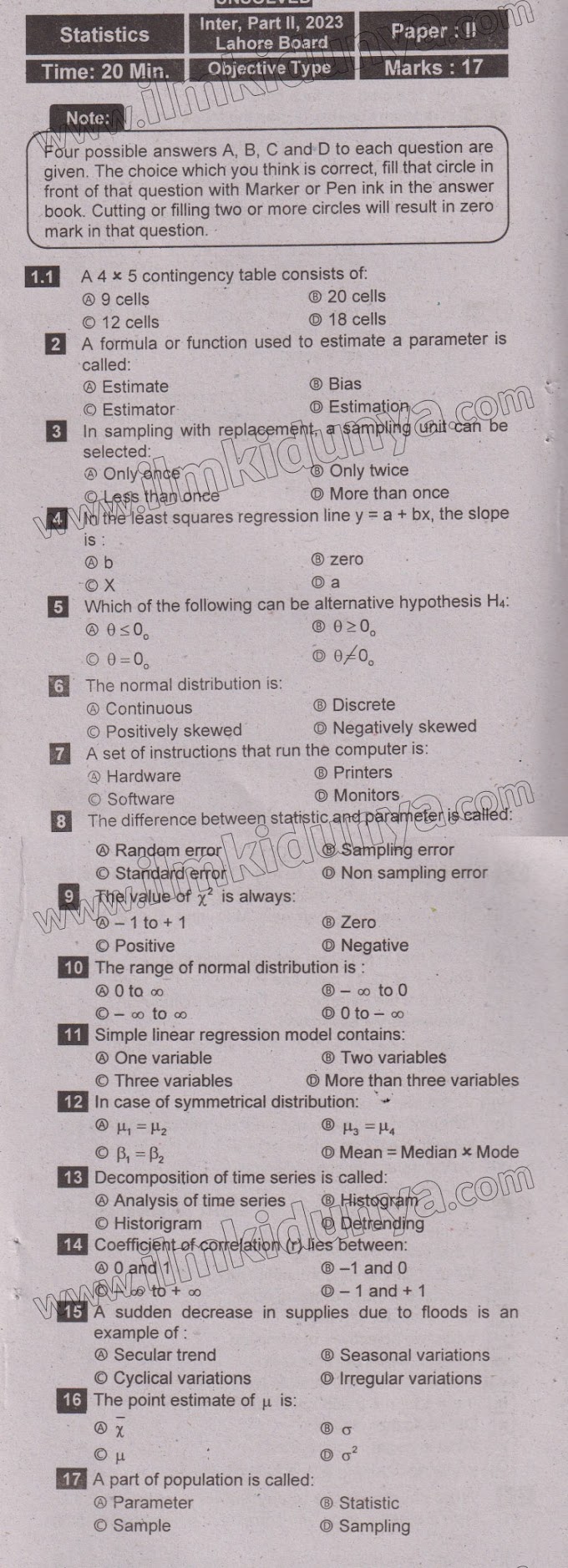Here you will see the important definitions and short questions of chapter 6 Probability. Very soon you will find the guess paper of this statistics book. Please My only request is to subscribe to this channel Welcome Academy on youtube.
Title:11th class statistics chapter 6 Probability,Probability,important definitions and short questions,1st year class
11th class,1st year class
chapter 6:Probability
(IMPORTANT SHORT QUESTIONS) CHAPTER # 6
|
DEFINITIONS |
ANSWERS |
||
|
1) Define Universal Set. |
A set containing all elements of a problem under consideration is called universal set. |
||
|
2) What is Conditional Probability? |
The probability associated with reduced sample space is called Conditional Probability. |
||
|
3) Define an Experiment. |
The process of obtaining observations is called an experiment. E.g. throwing a coin,rolling a die. |
||
|
4) Define Equally Liking Events. |
Two events are said to be equally likely if they have the same chance of occurring. When you toss a fair coin, you are equally likely to get a head or a tail. |
||
|
5) Define compound event. |
The event consists of more than one sample points of a sample space is called compound event. {2,4,6}, {HT,TH} etc. |
||
|
6) Give the sample space, when two fair coins are tossed? |
S={HH,HT,TT,TH}
|
||
|
7) A fair die is rolled once. What is the probability of even number? |
S={1,2,3,4,5,6} , n(S)=6 Let A= Even no. Appears A={2,4,6} , n(A)=2
|
||
|
8) Write equally likely events in toss of a coin. |
{H},{T} both events are equally likely as they have same chance of occurrence.
|
||
|
9) Write sample space for the experiment “Toss a pair of dices”. |
Sample space = {(1,1), (1,2),(1,3),(1,4),(1,5),(1,6),(2,1) ,(2,2),(2,3),(2,4),(2,5), (2,6), (3,1),(3,2),(3,3),(3,4),(3,5),(3,6), (4,1),(4,2),(4,3),(4,4),(4,5),(4,6), (5,1) ,(5,2),(5,3),(5,4),(5,5),(5,6), (6,1),(6,2),(6,3),(6,4),(6,5),(6,6)} |
||
|
10) Define subset. |
A set “A” is a subset of “B” if all elements of A exists in B.e.g if A={1,2} and B={1,4,5,6,3,2} then A is a subset of B. |
||
|
11) What is impossible event? |
|
||
|
12) What is meant by random experiment? |
The experiment is said to be random experiment if it gives different results even though it is repeated a large no of times under similar conditions. e.g. rolling dice, tossing coins etc. |
||
|
13) What is sample space? |
The sample space of an experiment is the set of all possible outcomes of that experiment. The sample space for tossing a coin:S= {H, T} |
||
|
14) Differentiate simple and composite events |
Simple event consists of only one outcome while compound event consists of more than two outcomes of a sample space. |
||
|
15) Given that P(A) = 1/3 and P(B) = ½, P(A ∩ B) =¼ then find P (A UB) |
P (A UB)= P(A)+ P(B)- P(A ∩ B) P (A UB)=1/3+1/2-1/4 P (A UB)=7/12 |
||
|
16) Make a ‘Sample Space’, when a cubical die is rolled |
S={1,2,3,4,5,6} |
||
|
17) Write the names of two important rules used for calculating probabilities. |
You need to use “Multiplication” and “Addition” rules when calculating probabilities. |
||
|
18) Define simple event. |
Simple event consists of only one outcome of a sample space.e.g {2},{HHT} |
||
|
19) A fair die is rolled once, what is the probability of dot ‘5’. |
S={1,2,3,4,5,6} P(5)=1/6 |
||
|
20) Define probability. |
The mathematical measurement of uncertainty is called probability.
|
||
|
21) State addition law of probability for mutually exclusive events. |
If A and B be two mutually exclusive events then P (A UB)= P(A)+ P(B) is called addition law of probability for mutually e xclusive events. |
||
|
22) What is the answer of ? |
|
Thanks for visiting this page.
Provided by @WelcomeAcademy











0 Comments
Thanks for message us We shall approve it if you have oxygen like words for us